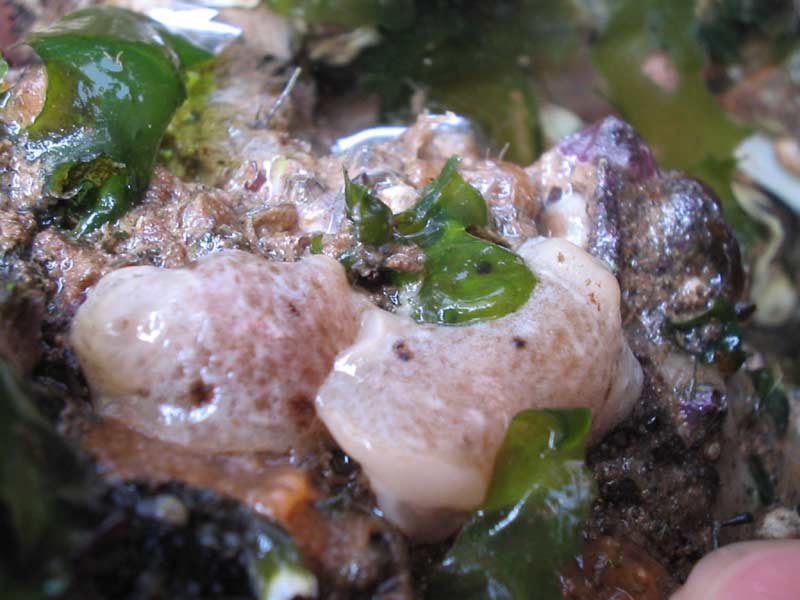Grey sea slug (Jorunna tomentosa)
Distribution data supplied by the Ocean Biodiversity Information System (OBIS). To interrogate UK data visit the NBN Atlas.Map Help
| Researched by | Judith Oakley | Refereed by | Admin |
| Authority | (Cuvier, 1804) | ||
| Other common names | - | Synonyms | Jorunna lemchei Ev. Marcus, 1976, Jorunna luisae Ev. Marcus, 1976 |
Summary
Description
Jorunna tomentosa is usually sandy brown in colour with a loosely paired series of dark brown blotches down the sides of the body. It grows to about 6 cm in length.The mantle of Jorunna tomentosa is velvety, caused by the dense covering of small, uniform tubercles with an array of protruding spicules (caryophyllidia). Each tubercle has a characteristic retractile central projecting finger. There are up to 17 tripinnate gills, located within a gill pocket. The oral tentacles are short, slender and finger-like. The foot projects posteriorly when crawling. Jorunna tomentosa feeds on encrusting siliceous sponges, especially Halichondria panicea and Haliclona spp. Its colour and texture ensure this sea slug is well camouflaged amongst the sponges.
Recorded distribution in Britain and Ireland
Recorded from most of the coast of Britain and Ireland.Global distribution
Recorded north to the Faroes and western Norway and south to Morocco and throughout the Mediterranean.Habitat
Common on the lower shore and shallow sublittoral on rocky coasts. Feeds on encrusting siliceous sponges especially Halichondria (Halichondria) panicea and Haliclona spp.Depth range
-Identifying features
- Colour usually sandy brown or sandy.
- Pair of short oral tentacles slender and finger-like.
- Loosely paired series of dark brown blotches down sides of body.
- Narrowly oval body.
- Up to 17 trilobed gills in a tight circle.
Additional information
Spawning is recorded February to August (Thompson & Brown, 1984). The spawn is a broad ribbon laid in neat, tight coil. Each spiral spawn mass contains up to 145,000 eggs (Thompson & Brown, 1984).
Listed by
- none -
Bibliography
Hayward, P., Nelson-Smith, T. & Shields, C. 1996. Collins pocket guide. Sea shore of Britain and northern Europe. London: HarperCollins.
Howson, C.M. & Picton, B.E., 1997. The species directory of the marine fauna and flora of the British Isles and surrounding seas. Belfast: Ulster Museum. [Ulster Museum publication, no. 276.]
JNCC (Joint Nature Conservation Committee), 1999. Marine Environment Resource Mapping And Information Database (MERMAID): Marine Nature Conservation Review Survey Database. [on-line] http://www.jncc.gov.uk/mermaid
MarLIN (Marine Life Information Network), 2005. SEArchable BEnthic Data (SEABED) Map [on-line]. Data Access Sub-programme, Marine Life Information Network for Britian and Ireland http://www.marlin.ac.uk,
Picton, B. E. & Morrow, C.C., 1994. A Field Guide to the Nudibranchs of the British Isles. London: Immel Publishing Ltd.
Rudman, W.B., 1999a. Jorunna tomentosa [on-line]. http://www.seaslugforum.net/factsheet.cfm?base=jorutome,
Thompson, T. E. & Brown, G. H., 1976. British Opisthobranch Molluscs. London: Academic Press. [Synopses of the British Fauna, no. 8.]
Thompson, T.E. & Brown, G.H., 1984. Biology of Opisthobranch Molluscs, vol. II. London: Ray Society.
Datasets
Centre for Environmental Data and Recording, 2018. Ulster Museum Marine Surveys of Northern Ireland Coastal Waters. Occurrence dataset https://www.nmni.com/CEDaR/CEDaR-Centre-for-Environmental-Data-and-Recording.aspx accessed via NBNAtlas.org on 2018-09-25.
Conchological Society of Great Britain & Ireland, 2018. Mollusc (marine) data for Great Britain and Ireland - restricted access. Occurrence dataset: https://doi.org/10.15468/4bsawx accessed via GBIF.org on 2018-09-25.
Conchological Society of Great Britain & Ireland, 2023. Mollusc (marine) records for Great Britain and Ireland. Occurrence dataset: https://doi.org/10.15468/aurwcz accessed via GBIF.org on 2024-09-27.
Fenwick, 2018. Aphotomarine. Occurrence dataset http://www.aphotomarine.com/index.html Accessed via NBNAtlas.org on 2018-10-01
Fife Nature Records Centre, 2018. St Andrews BioBlitz 2015. Occurrence dataset: https://doi.org/10.15468/xtrbvy accessed via GBIF.org on 2018-09-27.
Kent Wildlife Trust, 2018. Kent Wildlife Trust Shoresearch Intertidal Survey 2004 onwards. Occurrence dataset: https://www.kentwildlifetrust.org.uk/ accessed via NBNAtlas.org on 2018-10-01.
Manx Biological Recording Partnership, 2022. Isle of Man historical wildlife records 1990 to 1994. Occurrence dataset:https://doi.org/10.15468/aru16v accessed via GBIF.org on 2024-09-27.
Merseyside BioBank., 2018. Merseyside BioBank (unverified). Occurrence dataset: https://doi.org/10.15468/iou2ld accessed via GBIF.org on 2018-10-01.
NBN (National Biodiversity Network) Atlas. Available from: https://www.nbnatlas.org.
OBIS (Ocean Biodiversity Information System), 2025. Global map of species distribution using gridded data. Available from: Ocean Biogeographic Information System. www.iobis.org. Accessed: 2025-07-09
South East Wales Biodiversity Records Centre, 2018. SEWBReC Molluscs (South East Wales). Occurrence dataset: https://doi.org/10.15468/jos5ga accessed via GBIF.org on 2018-10-02.
South East Wales Biodiversity Records Centre, 2018. Dr Mary Gillham Archive Project. Occurance dataset: http://www.sewbrec.org.uk/ accessed via NBNAtlas.org on 2018-10-02
Citation
This review can be cited as:
Last Updated: 23/08/2007






